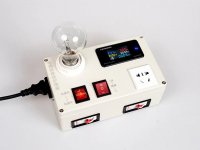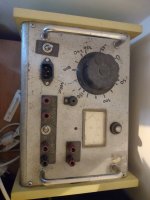You could always put one of these in line. Very handy if all else fails.
https://www.amazon.com/Operated-Con...-1-spons&sp_csd=d2lkZ2V0TmFtZT1zcF9hdGY&psc=1
https://www.amazon.com/Operated-Con...-1-spons&sp_csd=d2lkZ2V0TmFtZT1zcF9hdGY&psc=1
Some (unusally) usefull crap from AliX; https://www.aliexpress.com/item/1005003590590913.html?spm=a2g0o.order_list.0.0.2d971802l5zuIh
Attachments
Some (unusally) usefull crap from AliX; https://www.aliexpress.com/item/1005003590590913.html?spm=a2g0o.order_list.0.0.2d971802l5zuIh
Yes, along the same lines. Except I don't like digital ammeter because its not fast enough for you to see the start up surge current profile of an amp at switch on. They respond in increments, too slow. With an analog ammeter you can try out a few thermistors to see exactly if you've flattened your surge and you know exactly how long your surge lasts and exactly how it trails off. Cant do that with a digital ammeter, for volts its fine though.
I have this old thing that I think was built in a service shop. It used to be twice as long, with a 30V section, but it was just too big to be useful. The difference with the other suggestions here is that the variac is connected to an isolation transformer, and that output is sent to the device under test. There is also a rudimentary full wave rectifier with CRC smoothing for a 400V DC supply, if needed, and a 6.3v supply.
If I need a dim bulb test, I have a bulb with a banana plug and socket that I can put in series. It is useful to have bulbs with different wattages, so use a lower wattage for a lower power consuming device like a radio, and a higher one for an amp (otherwise it can be a bit inconclusive with higher current equipment).
Another useful addition is one of those 'watt' measuring plugs that record the power consumption of the device attached. If I need to see that data I just plug the contraption to the mains via that.
If I need a dim bulb test, I have a bulb with a banana plug and socket that I can put in series. It is useful to have bulbs with different wattages, so use a lower wattage for a lower power consuming device like a radio, and a higher one for an amp (otherwise it can be a bit inconclusive with higher current equipment).
Another useful addition is one of those 'watt' measuring plugs that record the power consumption of the device attached. If I need to see that data I just plug the contraption to the mains via that.
Attachments
It's absolutely a good idea to equip some stuff with magnetic switches for safety.
Woodworking equipment comes to mind...
All of my tube amps use latching power so they remain off if there's a power failure. The bias supply turns on B+, too. If there's a failure, B+ turns off instead of blowing things up.

Woodworking equipment comes to mind...
All of my tube amps use latching power so they remain off if there's a power failure. The bias supply turns on B+, too. If there's a failure, B+ turns off instead of blowing things up.
It's absolutely a good idea to equip some stuff with magnetic switches for safety.
Woodworking equipment comes to mind...
All of my tube amps use latching power so they remain off if there's a power failure. The bias supply turns on B+, too. If there's a failure, B+ turns off instead of blowing things up.
View attachment 1111875
I should probably do this as part of the bench power outlet to be used for breadboarding, good idea! And same to PRR who mentioned this lock-out earlier too. I'd rather consider this part of my house, not this box I'd build though. So I wouldn't need all the power strips for my oscilloscope, signal generator, meters, etc. plugged to it, but a great idea for the outlet that I plug this "Mains variac meter dim bulb" project into at the beginning. Then I just always use this outlet for experimenting. Ok now some electrical work on the wall switch!
If you're really worried, use a dead man's switch.
https://en.wikipedia.org/wiki/Dead_man's_switch
Not worried I've been breadboarding for over a year. I won't do a dead man switch. Just looking to integrate variac, dim bulb, ammeter, voltmeter, fuses, etc. in one device.
Still, a dead man's switch can be added with a sewing machine pedal and a cable 🙂 I don't need one, you don't either. Someone else might want it for peace of mind?
Not really. You may be able to catch the surge from the cold tube filaments, but you will miss the surge caused by the transformer itself. I measured a handful of transformers and found the transformer alone caused an instantaneous inrush current of hundreds of ampere. The EI core transformers common in tube amps may be a bit gentler than the toroids I measured, but probably not by much. You can read more and see graphs of the measured inrush current here: https://neurochrome.com/pages/the-ultimate-guide-to-soft-start-designYes, along the same lines. Except I don't like digital ammeter because its not fast enough for you to see the start up surge current profile of an amp at switch on. They respond in increments, too slow. With an analog ammeter you can try out a few thermistors to see exactly if you've flattened your surge and you know exactly how long your surge lasts and exactly how it trails off.
To capture the inrush current you'll need an oscilloscope and a current probe. I built one for about $10: https://neurochrome.com/pages/how-to-measure-current-with-an-oscilloscope-a-10-current-probe
I rather like that Alibaba box. Add a variac to it and be done.
Tom
You might want to double-check against your local electrical code before going down that route, though. Just saying. Or... You could integrate that function into your lab bench and plug your lab bench into a regular outlet. Then you can do just about whatever you want.[...] but a great idea for the outlet that I plug this "Mains variac meter dim bulb" project into at the beginning. Then I just always use this outlet for experimenting. Ok now some electrical work on the wall switch!
Tom
Not really. You may be able to catch the surge from the cold tube filaments, but you will miss the surge caused by the transformer itself. I measured a handful of transformers and found the transformer alone caused an instantaneous inrush current of hundreds of ampere. The EI core transformers common in tube amps may be a bit gentler than the toroids I measured, but probably not by much. You can read more and see graphs of the measured inrush current here: https://neurochrome.com/pages/the-ultimate-guide-to-soft-start-design
To capture the inrush current you'll need an oscilloscope and a current probe. I built one for about $10: https://neurochrome.com/pages/how-to-measure-current-with-an-oscilloscope-a-10-current-probe
I rather like that Alibaba box. Add a variac to it and be done.
Tom
Oh boy Tom thats a nice inrush sensor. That could be wired right into this box with a BNC on the front panel for accurate inrush monitoring built in. This can go on and on. A lot can go on between the outlet and your Amp all in the mains realm. variac, dim bulb, metering, fusing, switching, bypassing, panic shutdown and now a built in current sense! Are you selling those as little kits?
I do see surge with an analog 1A meter, no numbers, but you can tell if a thermistor is working or not even see when a timer relay shorts it off. But I see your point, and the scope really is much better.
Last edited:
to feed my variac and to get its output connected to this "box" I'd have to use a female outlet for the feed side then a boat/rv inlet for the return side.
feed to variac and return from variac
:

return from variac:

feed to variac and return from variac
:
return from variac:
Shoot, leave all that stuff off and get a video camera, quit being such a party pooper. 🙂
Regards
You mean mounted above the bench to record youtube videos? I have yet to post about my vacuum tube breadboarding system I've created and refining, with spring terminal bus fields that can take 24 to 14 AWG wire. This is all part of that effort/system of fast prototyping. I can easily prototype and tear down three or four amplifier schematics a week with just doing the hobby 2-3 hours a day. Some people use computers and simulation, I use parts and real electricity, rheostats to set operating points while watching meters and distortion readings, etc. A little thing like thinking to add an inline fuse on the mains has saved me a bad spark recently when I hooked up a resistor for a snubber wrong. So I think its time to really get control of mains. I know many others besides yourself might start to think the topic is "over the top", overkill, unnecessary, silly, etc. But I like fixtures for breadboarding, reliable things instead of a rat nest of gator clips across the bench.
I concur with your philosophy. It takes time to create the test tools, like with software development, but they are always a worthwhile investment. Plus you are less likely to take chances if you have a disciplined approach.
It could. Or you could keep it in your toolbox and use it whenever you need to measure current vs time. That's what I do.Oh boy Tom thats a nice inrush sensor. That could be wired right into this box with a BNC on the front panel for accurate inrush monitoring built in.
Nah. Just buy the current transformer, a resistor, and a BNC jack at Mouser and solder them together.Are you selling those as little kits?
For the power input/output, I'd use an IEC 320-C14 and IEC 320-C13. You can get both in chassis-mount versions and use a standard cord with them. Obviously the male connector is the input.
Tom
Don't lock-out your lights!!lock-out earlier too. I'd rather consider this part of my house, not this box
I'm with Tom: this is a test-bench or power-saw tool, NOT part of a house. At $17, I got two, one for each finger-height saw. I know that even a good gash in a thumb costs a LOT more than $17. (Even if we had 100% medical costs, the annoyance of cleaning blood off the saw and floor and ceiling, being unable to scratch your nose or a$$ with that finger, has value.)
Don't lock-out your lights!!
I'm with Tom: this is a test-bench or power-saw tool, NOT part of a house. At $17, I got two, one for each finger-height saw. I know that even a good gash in a thumb costs a LOT more than $17. (Even if we had 100% medical costs, the annoyance of cleaning blood off the saw and floor and ceiling, being unable to scratch your nose or a$$ with that finger, has value.)
Makes sense Looking for a smaller lockout switch on the box.
This one is only 2 inches long, Ill still have my plunger stop switch, but this switch can be the main power on switch. When power is lost and restored it won't be engaged.
https://www.amazon.com/POWERTEC-713...emergency+stop+magnetic+button,aps,100&sr=8-9
Last edited:
- Home
- Amplifiers
- Tubes / Valves
- Over the top dim bulb tester, improvements

